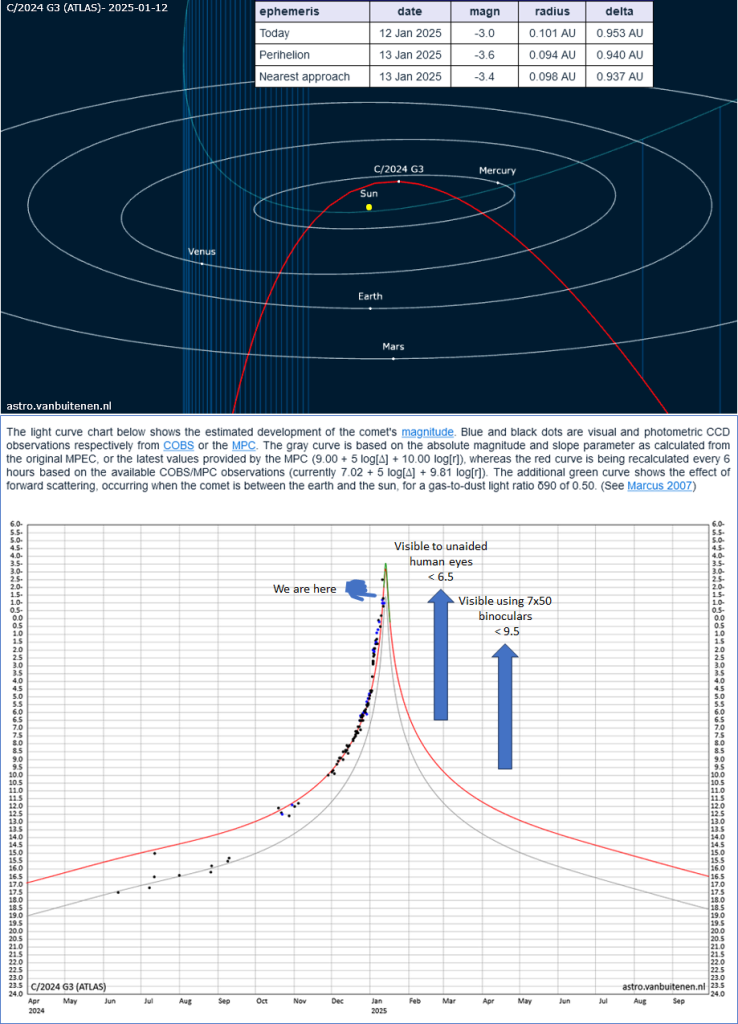Now that we have everyone excited about the Mars occultation tomorrow, here is another exciting visitor from space putting on a show as we speak.
Comet C/2024 G3 (ATLAS) is closing in on the Sun for perihelion on Jan 13, 10:17 UTC.
Currently at mag -3.0, it will brighten to mag -3.6.
But it is difficult to observe from the Northern hemisphere. It will be difficult even after perihelion, assuming it survives this grazing trip around the Sun.
https://astro.vanbuitenen.nl/comet/2024G3
https://en.wikipedia.org/wiki/C/2024_G3_(ATLAS)
1/n
Comet C/2024 G3 (ATLAS) is closing in on the Sun for perihelion on Jan 13, 10:17 UTC.
Currently at mag -3.0, it will brighten to mag -3.6.
But it is difficult to observe from the Northern hemisphere. It will be difficult even after perihelion, assuming it survives this grazing trip around the Sun.
https://astro.vanbuitenen.nl/comet/2024G3
https://en.wikipedia.org/wiki/C/2024_G3_(ATLAS)
1/n
Dieser Beitrag wurde bearbeitet. (3 Monate her)


AkaSci 🛰️ •
☄️ 🚀
#Comet #C2024G3
2/n
AkaSci 🛰️ •
The website shows a multi-day visualization of the comet as it survives perihelion and develops a bright tail that persists for several days thereafter.
Check out the website for the full visualization - https://hdr-astrophotography.com/
Credit: Nicolas Lefaudeux
3/n
HDR astrophotography by Nicolas Lefaudeux
HDR astrophotography by Nicolas LefaudeuxAkaSci 🛰️ •
The image was taken by the Large Angle and Spectrometric COronagraph (LASCO) instrument aboard the NASA/ESA SOHO (Solar and Heliospheric Observatory) spacecraft.
You can see a time-lapse video at https://www.swpc.noaa.gov/products/lasco-coronagraph
https://soho.nascom.nasa.gov/data/realtime/c3/512/
4/n
AkaSci 🛰️ •
Perhaps, it did.
Here is an image of the Sun's corona taken by the NASA/ESA SOHO spacecraft with Comet C/2024 G3 (ATLAS) in the view, about 15 hours after perihelion.
The image was taken by the Large Angle and Spectrometric COronagraph (LASCO) instrument aboard the NASA/ESA SOHO (Solar and Heliospheric Observatory) spacecraft.
#Comet
https://soho.nascom.nasa.gov/data/realtime/c3/512/
5/n
AkaSci 🛰️ •
The image was taken by the Large Angle and Spectrometric COronagraph (LASCO) instrument aboard the NASA/ESA SOHO (Solar and Heliospheric Observatory) spacecraft.
https://soho.nascom.nasa.gov/data/realtime/c3/512/
6/n
AkaSci 🛰️ •
Ideally, you want the comet to be located sufficiently above or below the Sun, but in the case of New York, it is located just slightly above the Sun for a few days and to the side after that.
Sydney OTOH has a much favorable view of the comet as seen below.
https://stellarium-web.org/
7/n
Stellarium Web Online Star Map
stellarium-web.orgAkaSci 🛰️ •
Canon R6 + 70-200/2.8 @ 200mm, 15 x 1 sec
https://www.instagram.com/p/DE7_iz5JbQM/
Yuri's artwork is available for purchase at https://fineartamerica.com/profiles/yuri-beletsky/shop
#Comet #C2024G3
8/n
Yuri Beletsky - Official Art Store
Yuri Beletsky (Fine Art America)Torsten mag das.
MPS Göttingen hat dies geteilt